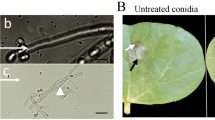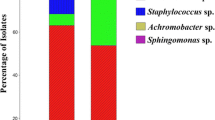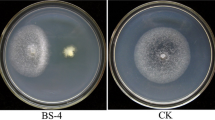Abstract
A novel strain of Bacillus isolated from rhizosphere has shown to be an excellent biocontrol agent against various plant pathogens. In this study, a first report of a Bacillus strain NKMV-3 which effectively controls Alternaria solani, which cause the early blight disease in tomato. Based on the cultural and molecular sequencing of 16S rRNA gene sequence, the identity of the strain was confirmed as Bacillus velezensis NKMV-3. The presence of the lipopeptide which are antibiotic synthesis genes, namely iturin C, surfactin A and fengycin B and D, was confirmed through gene amplification. In addition, lipopeptides were also confirmed through liquid chromatography. The extract showed inhibitory effect against A. solani in vitro and detached tomato leaf assays. Bacillus velezensis strain NKMV-3-based formulations may provide an effective solution in controlling early blight disease in tomato and other crops.








Similar content being viewed by others
Data availability
Not applicable.
References
Awan, Z. A., & Shoaib, A. (2019). Combating early blight infection by employing Bacillus subtilis in combination with plant fertilizers. Current Plant Biology., 20, 100125. https://doi.org/10.1016/j.cpb.2019.100125
Rubén, D., Gullon, P., Pateiro, M., Munekata, P. E. S., Zhang, W., & Lorenzo, J. M. (2020). Tomato as Potential Source of Natural Additives. Antioxidants, 9(1), 73.
Viuda-Martos, M., Sanchez-Zapata, E., Sayas-Barberá, E., Sendra, E., Pérez-Álvarez, J. A., & Fernández-López, J. (2014). Tomato and Tomato Byproducts. Human Health Benefits of Lycopene and Its Application to Meat Products: A Review. Critical Reviews in Food Science and Nutrition, 54(8), 1032–1049. https://doi.org/10.1080/10408398.2011.623799
Garg, S., Ram Kumar, D., Yadav, S., Kumar, M., Yadav, J. (2020). Alternaria Blight of Tomato: A Review of Disease and Pathogen Management Approaches. Acta Scientific Agriculture, 4(11), 08–15. https://doi.org/10.31080/asag.2020.04.0908
Adhikari, P., Oh, Y., Panthee, D. R. (2017). Current status of early blight resistance in tomato: An update. International Journal of Molecular Scienceshttps://doi.org/10.3390/ijms18102019
Muthu-Pandian Chanthini, K., Senthil-Nathan, S., Soranam, R., Thanigaivel, A., Karthi, S., Sreenath Kumar, C., Kanagaraj Murali-Baskaran, R. (2019). Bacterial compounds, as biocontrol agent against early blight (Alternaria solani) and tobacco cut worm (Spodoptera litura Fab.) of tomato (Lycopersicon esculentum Mill.). Archives of Phytopathology and Plant Protection, https://doi.org/10.1080/03235408.2018.1496525
Biswas, S. (2016). Integrated Disease Management of Early Blight in Tomato Caused by Alternaria Solani Sorauer.” https://krishikosh.egranth.ac.in/handle/1/5810035222.
Chavan, V. A., Borkar, S. G. (2020). Strategies for Management of Fungicide Resistance in Tomato Leaf Blight Pathogen Alternaria Solani in 10 Districts of Western Maharashtra in India. Strate GSC Biological Pharmaceutical Sciences, 12(3), 180–188. https://doi.org/10.30574/gscbps.2020.12.3.0280
Bauske, M. J., & Gudmestad, N. C. (2018). Parasitic Fitness of Fungicide-Resistant and -Sensitive Isolates of Alternaria Solani .Plant Disease, 102(3), 666–673. https://doi.org/10.1094/PDIS-08-17-1268-RE
Hassaan, M. A., El Nemr, A. (2020). Pesticides Pollution: Classifications, Human Health Impact, Extraction and Treatment Techniques. Egyptian Journal Aquatic Researchhttps://doi.org/10.1016/j.ejar.2020.08.007
Tudi, M., Ruan, H. D., Wang, L., Lyu, J., Sadler, R., Connell, D., & Phung, D. T. (2021). Agriculture Development, Pesticide Application and Its Impact on the Environment International Journal of Environmental Research Public Health. https://doi.org/10.3390/ijerph18031112
Hobbelen, P. H. F., Paveley, N. D., Van Den Bosch, F. (2014). The Emergence of Resistance to Fungicides. PLoS ONE, 9(3), 91910https://doi.org/10.1371/journal.pone.0091910
Baibakova, E. V., Nefedjeva, E. E., Suska-Malawska, M., Wilk, M., Sevriukova, G. A., & Zheltobriukhov, V. F. (2019). Modern Fungicides: Mechanisms of Action, Fungal Resistance and Phytotoxic Effects. Annual Research & Review in Biology., 32(3), 1–16. https://doi.org/10.9734/arrb/2019/v32i330083
Hollomon, D. W. (2015). Fungicide Resistance: Facing the Challenge – a Review. Plant Prot. Sci. 51(4), 170–176. https://doi.org/10.17221/42/2015-PPS
Köhl, J., Kolnaar, R., & Ravensberg, W. J. (2019). Mode of Action of Microbial Biological Control Agents Against Plant Diseases: Relevance Beyond Efficacy. Frontiers in Plant Science. https://doi.org/10.3389/fpls.2019.00845
Heydari, A., & Pessarakli, M. (2010). A Review on Biological Control of Fungal Plant Pathogens Using Microbial Antagonists .Journal of Biological Sciences. https://doi.org/10.3923/jbs.2010.273.290
Shafi, J., Tian, H., Ji, M. (2017). Bacillus Species as Versatile Weapons for Plant Pathogens: A Review. Biotechnol. Biotech. Equip., https://doi.org/10.1080/13102818.2017.1286950
Andrić, S., Meyer, T., & Ongena, M. (2020). Bacillus Responses to Plant-Associated Fungal and Bacterial Communities. Frontiers in Microbiology. https://doi.org/10.3389/fmicb.2020.01350
Rabbee, M. F., Baek, K.-H. (2020).Antimicrobial Activities of Lipopeptides and Polyketides of Bacillus Velezensis for Agricultural Applications. Molecules, 25(21). https://doi.org/10.3390/MOLECULES25214973
Fan, B., Wang, C., Song, X., Ding, X., Wu, L., Wu, H., & Borriss, R. (2018). Bacillus Velezensis FZB42 in 2018: The Gram-Positive Model Strain for Plant Growth Promotion and Biocontrol. Frontiers in Microbiology. https://doi.org/10.3389/fmicb.2018.02491
Chen, M., Wang, J., Liu, B., Zhu, Y., Xiao, R., Yang, W., & Chen, Z. (2020). Biocontrol of Tomato Bacterial Wilt by the New Strain Bacillus Velezensis FJAT-46737 and Its Lipopeptides. BMC Microbiology, 20(1), 1–12. https://doi.org/10.1186/s12866-020-01851-2
Choi, T. G., Maung, C. E. H., Lee, D. R., Henry, A. B., Lee, Y. S., & Kim, K. Y. (2020). Role of Bacterial Antagonists of Fungal Pathogens, Bacillus Thuringiensis KYC and Bacillus Velezensis CE 100 in Control of Root-Knot Nematode, Meloidogyne Incognita and Subsequent Growth Promotion of Tomato. Biocontrol Science and Technology., 30(7), 685–700. https://doi.org/10.1080/09583157.2020.1765980
Xiang, N., Lawrence, K. S., Kloepper, J. W., Donald, P. A., McInroy, J. A., & Lawrence, G. W. (2017). Biological Control of Meloidogyne Incognita by Spore-Forming Plant Growth-Promoting Rhizobacteria on Cotton. Plant Disease, 101(5), 774–784. https://doi.org/10.1094/PDIS-09-16-1369-RE
Shanmugam, V., Atri, K., Gupta, S., Kanoujia, N., & Naruka, D. S. (2011). Selection and Differentiation of Bacillus Spp. Antagonistic to Fusarium Oxysporum f.Sp. Lycopersici and Alternaria Solani Infecting Tomato. Folia Microbiologica, 56(2), 170–177. https://doi.org/10.1007/s12223-011-0031-3
Pane, C., & Zaccardelli, M. (2015). Evaluation of Bacillus Strains Isolated from Solanaceous Phylloplane for Biocontrol of Alternaria Early Blight of Tomato. Biological Control, 84, 11–18. https://doi.org/10.1016/j.biocontrol.2015.01.005
Etebarian, H.-R., Sholberg, P. L., Eastwell, K. C., & Sayler, R. J. (2005). Biological Control of Apple Blue Mold with Pseudomonas Fluorescens. Canadian Journal of Microbiology., 51(7), 591–598. https://doi.org/10.1139/w05-039
Bergey, D., & John, G. H. (1994). Bergey’s manual of determinative bacteriology (9th ed.). Williams & Wilkins.
White, T. J., Bruns, T. D., Lee, S. B., & Taylor, J. W. (1990). Amplification and Direct Sequencing of Fungal Ribosomal Rna Genes for Phylogenetics. PCR protocols: a guide to methods and applications. (M. A. Innis, Ed.). San Diego: Academic Press.
Kumar, S., Stecher, G., & Tamura, K. (2016). MEGA7: Molecular Evolutionary Genetics Analysis Version 7.0 for Bigger Datasets. Molecular Biology and Evolution., 33(7), 1870–1874. https://doi.org/10.1093/molbev/msw054
Li, Z., Guo, B., Wan, K., Cong, M., Huang, H., & Ge, Y. (2015). Effects of Bacteria-Free Filtrate from Bacillus Megaterium Strain L2 on the Mycelium Growth and Spore Germination of Alternaria Alternata. Biotechnology & Biotechnological Equipment., 29(6), 1062–1068. https://doi.org/10.1080/13102818.2015.1068135
Chung, S., Kong, H., Buyer, J. S., Lakshman, D. K., Lydon, J., Kim, S.-D., & Roberts, D. P. (2008). Isolation and Partial Characterization of Bacillus Subtilis ME488 for Suppression of Soilborne Pathogens of Cucumber and Pepper. Applied Microbiology and Biotechnology., 80(1), 115–123. https://doi.org/10.1007/s00253-008-1520-4
Płaza, G., Chojniak, J., Rudnicka, K., Paraszkiewicz, K., & Bernat, P. (2015). Detection of Biosurfactants in Bacillus Species: Genes and Products Identification..Journal of Applied Microbiology., 119(4), 1023–1034. https://doi.org/10.1111/jam.12893
Lin, L.-Z., Zheng, Q.-W., Wei, T., Zhang, Z.-Q., Zhao, C.-F., Zhong, H., & Guo, L.-Q. (2020). Isolation and Characterization of Fengycins Produced by Bacillus Amyloliquefaciens JFL21 and Its Broad-Spectrum Antimicrobial Potential Against Multidrug-Resistant Foodborne Pathogens.Frontiers in Microbiology., 11, 579621. https://doi.org/10.3389/fmicb.2020.579621
Zouari, I., Jlaiel, L., Tounsi, S., & Trigui, M. (2016). Biocontrol Activity of the Endophytic Bacillus Amyloliquefaciens Strain CEIZ-11 against Pythium Aphanidermatum and Purification of Its Bioactive Compounds. Biological Control, 100, 54–62. https://doi.org/10.1016/j.biocontrol.2016.05.012
Dhanarajan, G., Rangarajan, V., Sridhar, P. R., & Sen, R. (2016). Development and Scale-up of an Efficient and Green Process for HPLC Purification of Antimicrobial Homologues of Commercially Important Microbial Lipopeptides.ACS Sustainable Chemistry & Engineering., 4(12), 6638–6646. https://doi.org/10.1021/acssuschemeng.6b01498
Sharma, D., Ansari, M. J., Gupta, S., Al Ghamdi, A., Pruthi, P., Pruthi, V. (2015). Structural Characterization and Antimicrobial Activity of a Biosurfactant Obtained From Bacillus Pumilus DSVP18 Grown on Potato Peels. Jundishapur Journal of Microbiology. 8(9). https://doi.org/10.5812/jjm.21257
Ali, G. S., El-Sayed, A. S. A., Patel, J. S., Green, K. B., Ali, M., Brennan, M., & Norman, D. (2016). Ex Vivo Application of Secreted Metabolites Produced by Soil-Inhabiting Bacillus Spp. Efficiently Controls Foliar Diseases Caused by Alternaria Spp.Applied and Environmental Microbiology., 82(2), 478–490. https://doi.org/10.1128/AEM.02662-15
Pansuriya, D., Poonam, P. S., & Mohammed, F. (2021). Early Blight (Alternaria Solani) Etiology, Morphology, Epidemiology and Management of Tomato: Review Article. Dipen, D., 10(5), 1423–1428.
Tomer, A., Uday Kiran Reddy, C., Diwivedi, S. K. (n.d.). A Review on Early Blight of Tomato Menacing Disease Caused by Alternaria Solani.European Journal of Molecular & Clinical Medicine.
Deshmukh, Cd, D., Pb, K., Pr, B. (2020). Efficacy of Different Botanicals against the Alternaria Solani under in Vitro Conditions. Journal of Pharmacognosy and Phytochemistry. 9(6), 1986–1989.
Akram, S., Umar, U. ud D., Atiq, R., Tariq, A., Mahmood, M. A., Ateeq-ur-Rehman. (2018). Emerging Resistance in Alternaria Solani Against Different Fungicides in Southern Punjab, Pakistan. Pakistan Journal of Life and Social Sciences. 16(2), 117–123.
Bejarano, A., & Puopolo, G. (2020). Bioformulation of Microbial Biocontrol Agents for a Sustainable Agriculture.” In How Research Can Stimulate the Development of Commercial Biological Control Against Plant Diseases. Cham: Springer International Publishing. https://doi.org/10.1007/978-3-030-53238-3_16
Zhang, D., Yu, S., Yang, Y., Zhang, J., Zhao, D., Pan, Y., … Zhu, J. (2020).Antifungal Effects of Volatiles Produced by Bacillus Subtilis Against Alternaria Solani in Potato. Frontiers in Microbiology. 11. https://doi.org/10.3389/fmicb.2020.01196
Meng, Q., Jiang, H., & Hao, J. J. (2016). Effects of Bacillus velezensis strain BAC03 in promoting plant growth. Biological Control, 98, 18–26. https://doi.org/10.1016/j.biocontrol.2016.03.010
Cui, L., Yang, C., Wei, L., Li, T., & Chen, X. (2020). Isolation and Identification of an Endophytic Bacteria Bacillus Velezensis 8-4 Exhibiting Biocontrol Activity against Potato Scab. Biological Control, 141, 104156. https://doi.org/10.1016/j.biocontrol.2019.104156
Nam, M. H., Park, M. S., Kim, H. G., & Yoo, S. J. (2009). Journal of Microbiology. Biological Control of Strawberry Fusarium Wilt Caused by Fusarium Oxysporum f. Sp. Fragariae Using Bacillus Velezensis BS87 and RK1 Formulation. Biotechnology, 19(5), 520–524. https://doi.org/10.4014/jmb.0805.333
Bafana, A., Chakrabarti, T., & Devi, S. S. (2008). Azoreductase and Dye Detoxification Activities of Bacillus Velezensis Strain AB. Applied Microbiology and Biotechnology., 77(5), 1139–1144. https://doi.org/10.1007/s00253-007-1212-5
Wang, C., Zhao, D., Qi, G., Mao, Z., Hu, X., Du, B., … Ding, Y. (2020). Effects of Bacillus Velezensis FKM10 for Promoting the Growth of Malus Hupehensis Rehd. and Inhibiting Fusarium Verticillioides. Frontiers in Microbiology. 10, 2889. https://doi.org/10.3389/fmicb.2019.02889
Dhouib, H., Zouari, I., Ben Abdallah, D., Belbahri, L., Taktak, W., Triki, M. A., & Tounsi, S. (2019). Potential of a Novel Endophytic Bacillus Velezensis in Tomato Growth Promotion and Protection against Verticillium Wilt Disease. Biological Control, 139, 104092. https://doi.org/10.1016/j.biocontrol.2019.104092
Chen, L., Heng, J., Qin, S., & Bian, K. (2018). A Comprehensive Understanding of the Biocontrol Potential of Bacillus Velezensis LM2303 against Fusarium Head Blight. PLoS ONE, 13(6), e0198560. https://doi.org/10.1371/journal.pone.0198560
Author information
Authors and Affiliations
Contributions
VM: data acquisition, manuscript writing. BNV: data analysis. DM: proofreading; characterization. SRM: project guidance and correspondence.
Corresponding authors
Ethics declarations
Ethics Approval
Not applicable.
Consent to Participate
Not applicable.
Consent to Publish
Not applicable.
Conflict of Interest
The authors declare no competing interests.
Additional information
Publisher's Note
Springer Nature remains neutral with regard to jurisdictional claims in published maps and institutional affiliations.
Rights and permissions
About this article
Cite this article
Vignesh, M., Shankar, S.R.M., MubarakAli, D. et al. A Novel Rhizospheric Bacterium: Bacillus velezensis NKMV-3 as a Biocontrol Agent Against Alternaria Leaf Blight in Tomato. Appl Biochem Biotechnol 194, 1–17 (2022). https://doi.org/10.1007/s12010-021-03684-9
Received:
Accepted:
Published:
Issue Date:
DOI: https://doi.org/10.1007/s12010-021-03684-9




